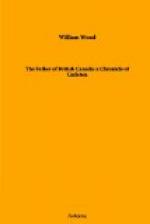‘Murray’s Report’ of 1762 gives us a good view of the Canada of that day and shows the attitude of the British towards their new possession. Canada had been conquered by Great Britain, with some help from the American colonies, for three main reasons: first, to strike a death-blow at French dominion in America; secondly, to increase the opportunities of British seaborne trade; and, thirdly, to enlarge the area available for British settlement. When Murray was instructed to prepare a report on Canada he had to keep all this in mind; for the government wished to satisfy the public both at home and in the colonies. He had to examine the military strength of the country and the disposition of its population in case of future wars with France. He had to satisfy the natural curiosity of men like the London merchants. And he had to show how and where English-speaking settlers could go in and make Canada not only a British possession but the fourteenth British colony in North America. Burton and Gage were also instructed to report about their own districts of Three Rivers and Montreal. The documents they prepared were tacked on to Murray’s. By June 1762 the work was completed and sent on to Amherst, who sent it to England in ample time to be studied there before the opening of the impending negotiations for peace.
Murray was greatly concerned about the military strength of Quebec, then, as always, the key of Canada. Like the unfortunate Montcalm he found the walls of Quebec badly built, badly placed, and falling into ruins, and he thought they could not be defended by three thousand men against ‘a well conducted Coup-de-main.’ He proposed to crown Cape Diamond with a proper citadel, which would overawe the disaffected in Quebec itself and defend the place against an outside enemy long enough to let a British fleet come up to its relief. The rest of the country was defended by little garrisons at Three Rivers and Montreal as well as by several small detachments distributed among the trading-posts where the white men and the red met in the depths of the western wilderness.




